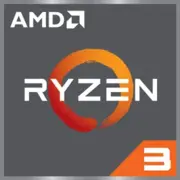AMD Ryzen 3 PRO 5350GE

AMD Ryzen 3 PRO 5350GE: Compact Power for Work and Home Tasks
April 2025
1. Key Specifications: Architecture and Key Features
Architecture and Technology Process
The AMD Ryzen 3 PRO 5350GE processor is based on the Zen 3 (Cezanne) microarchitecture and is manufactured using TSMC's 7nm FinFET technology. This provides high energy efficiency: with a TDP of 35 W, the chip delivers balanced performance for office and multimedia tasks.
Cores, Cache, and Graphics
- 4 Cores / 8 Threads — optimal for multitasking within basic scenarios.
- 8 MB L3 Cache — accelerates processing of frequently used data.
- Integrated Radeon Graphics (7 Cores) — supports 4K displays and handles less demanding games (e.g., CS:GO or Dota 2 at medium settings).
Performance
- Geekbench 6: Single-Core — 1864, Multi-Core — 5524. For comparison, the Intel Core i3-12100 (2024) scores ~1900/5600 but lacks built-in Vega-level graphics.
- Key Features: Support for PRO Security technologies (data encryption), PRO Manageability (remote management), and AMD GuardMI (protection against physical attacks).
2. Compatible Motherboards: Sockets and Chipsets
AM4 Socket
The Ryzen 3 PRO 5350GE uses the AM4 socket, allowing for a wide range of motherboard choices.
Recommended Chipsets:
- B550 — optimal for most users: supports PCIe 4.0, memory overclocking (up to DDR4-4400), and has USB 3.2 Gen2 (10 Gbps). Example: ASUS TUF Gaming B550M-Plus ($120-140).
- A520 — budget option without overclocking, but with basic functionality. Example: Gigabyte A520M S2H ($70-85).
- X570 — excessive for this processor but suitable for future upgrades.
Selection Tips:
- Check for BIOS version Pinnacle Pi 1.2.0.7 or newer.
- For compact builds, consider the Micro-ATX form factor.
3. Supported Memory: DDR4 and Tuning Nuances
Memory Type
The processor works only with DDR4 (DDR5 is not supported). The maximum frequency is 3200 MHz (in JEDEC mode), but with manual tuning, it can reach 3600-3800 MHz on compatible motherboards.
Recommendations:
- Use dual-channel kits (2x8 GB DDR4-3200) to increase bandwidth.
- Popular models: Corsair Vengeance LPX 16 GB ($45-55) or Kingston Fury Renegade 32 GB ($90-110).
4. Power Supply: Power Calculation and Model Selection
Power Consumption
With a TDP of 35 W, a system with the Ryzen 3 PRO 5350GE consumes:
- ~90-120 W without a discrete GPU.
- ~250-300 W with a GPU like the NVIDIA GTX 1650.
Recommended PSUs:
- For office PCs: Corsair CX450 (450 W, 80+ Bronze, $55).
- For gaming builds: Seasonic Focus GX-550 (550 W, 80+ Gold, $90).
Important: Don’t skimp on the power supply — low-quality models can reduce system stability.
5. Pros and Cons of AMD Ryzen 3 PRO 5350GE
Strengths:
- Energy efficiency: Ideal for mini-PCs and systems with passive cooling.
- Reliable integrated graphics.
- Support for PRO technologies for the business environment.
Weaknesses:
- Only 4 cores — a bit weak for rendering or streaming.
- No PCIe 4.0 (only PCIe 3.0).
- Does not support DDR5.
6. Use Cases: Where the Processor Unleashes Its Potential
- Office Tasks: Working with documents, browser (20+ tabs), video conferencing.
- Multimedia: Streaming video (Netflix, YouTube 4K), photo editing in Lightroom.
- Light Gaming: Fortnite at 720p/30 FPS or Minecraft on high settings.
- Home Server: With its low TDP, the chip is suitable for NAS or media centers.
7. Comparison with Competitors
Intel Core i3-13100 (2024):
- Similar single-threaded performance (~1900 in Geekbench 6).
- No integrated graphics (a separate GPU is required).
- Price: ~$130-140.
AMD Ryzen 5 5600G:
- 6 Cores / 12 Threads, Vega 7.
- Higher performance in gaming and multitasking, but with a TDP of 65 W.
- Price: ~$160-170.
Conclusion: The Ryzen 3 PRO 5350GE has an advantage over competitors due to its integrated graphics and PRO features, but falls short in multi-threaded workloads.
8. Practical Assembly Tips
- Case: The Fractal Design Node 202 ($100) is suitable for mini-PCs, while the Cooler Master MasterBox Q300L ($60) works well for standard builds.
- Cooling: The stock cooler is sufficient, but for quiet operation, choose the Noctua NH-L9a-AM4 ($45).
- Storage: Use NVMe SSDs (e.g., WD Blue SN580 1 TB, $70) to speed up system boot times.
9. Final Conclusion: Who is the Ryzen 3 PRO 5350GE Suitable For?
This processor is an ideal choice for:
1. Office PCs: Reliability, security, and low energy consumption.
2. Home Theaters: 4K video and compact form factor.
3. Budget Builds: A base for systems with upgrade potential (e.g., adding a discrete GPU).
The processor price in 2025 is $110-125, making it one of the best in the "price-to-performance" segment. If you don’t need 6 cores or PCIe 4.0, the Ryzen 3 PRO 5350GE will serve as a sensible compromise between performance and savings.
Basic
CPU Specifications
Memory Specifications
GPU Specifications
Miscellaneous
Benchmarks
Compared to Other CPU
Share in social media
Or Link To Us
<a href="https://cputronic.com/cpu/amd-ryzen-3-pro-5350ge" target="_blank">AMD Ryzen 3 PRO 5350GE</a>